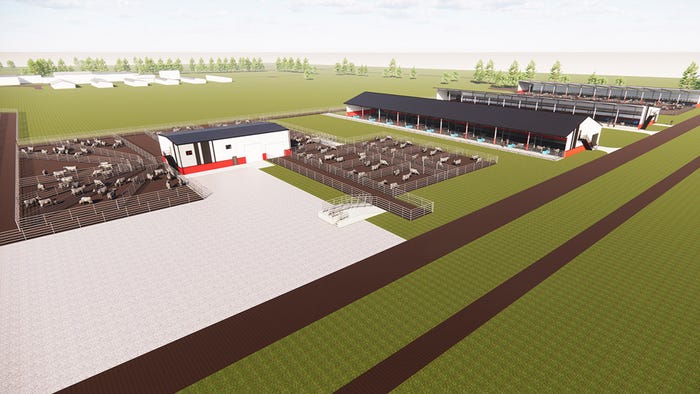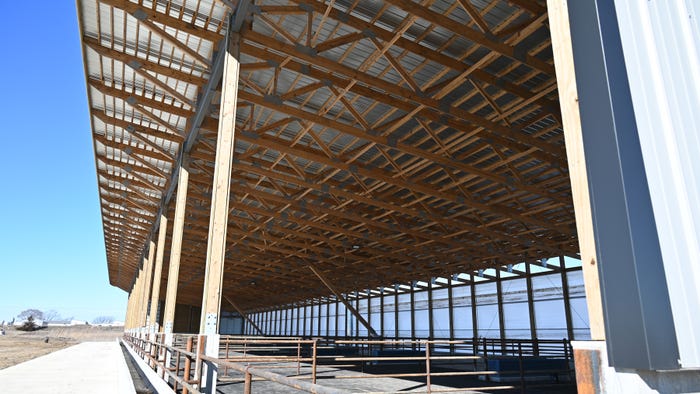
John Klosterman will not get to see the completion of the University of Nebraska Klosterman Feedlot Innovation Center, which will open this spring. The David City native passed away on Jan. 7, 2023.
As a family with a passion for farming and the beef industry, John and his wife, Beth, have been major contributors to the ag and beef industries, the Institute of Agriculture and Natural Resources, and the University of Nebraska-Lincoln over the years — including, most recently, a contribution toward the new $7.2 million feedlot research facility rising from the fields at the Eastern Nebraska Research Extension and Education Center south of Mead, Neb., that bears their family name.
Their contribution, along with numerous other major donors, have made this facility possible.

WHAT IT WILL LOOK LIKE: An artistic drawing of how Klosterman Feedlot Innovation Center will look when it is completed this spring shows the different enclosed feeding facilities, open pens and handling barn to the left. (UNL)
When it is opened this spring, it will double the size of the feedlot research capacity at ENREEC to 5,000 head, and the facility will be the largest commercial-scale feedlot research complex at a university in the world.
Nebraska Farmer made a couple of trips to ENREEC and walked through the Klosterman facility, which was still under construction at the time, with Doug Zalesky, ENREEC director, and Derek McLean, dean of the UNL Agricultural Research Division.
Unique research
According to Zalesky, the planning for this one-of-a-kind facility started four or five years before ground was broken in November 2022. ENREEC is fittingly celebrating its 60th anniversary from when the first feedlot pens were built there in 1964. The new facility will include open feedlot pens, some of which will be surfaced with rolled compressed concrete.
Other major structures include a mono-slope-roofed barn and a gable-roofed barn for enclosed facility feedlot research. A 240-head capacity feeding technology facility, named for the late Terry Klopfenstein, a renowned UNL ruminant researcher, will allow researchers to use precision technology to study feedlot protocols and results on individual animals.
Two independent processing facilities have been donated from Daniels Manufacturing Co. and ArrowQuip — showcasing ways to optimize cattle handling relative to cattle and people — as part of a facility headquarters, handling unit and classroom space.
“This project started several years ago,” McLean says, “when we recognized that to really do research that benefits the Nebraska beef industry, we needed to have facilities that replicated what the industry standards are on a feedlot.”
As planning and fundraising began, the project became a strong public-private partnership developed into what is the premiere feedlot research center located within UNL.
“This demonstrates the value that we at UNL place on beef research in support of the industry,” McLean adds. “From a research standpoint, this represents a great opportunity to do research, with the Klopfenstein Feed Technology complex within the facility, for instance, where we can study individual animals and how they respond to specific feed, feed additives and other inputs.”
Zalesky adds that the Klosterman facility includes different housing scenarios for study, including different styles of enclosed feeding barns, as well as outdoor pens where different surfaces, how animals respond to those specific conditions, and manure handling systems within those conditions can be studied.
Animal and worker safety
“Through these facilities, we can get an evaluation on impacts on animal health and worker safety,” McLean says. “We will have experiential learning opportunities for students, giving students a chance for hands-on experiences, and allowing them to observe varied feeding systems, bedding systems, pen scenarios and how animals respond to these different conditions.”
Finally, McLean acknowledges that the research facility will give UNL new opportunities to reach out to consumers and the public, so they can gain a better understanding of the ways Nebraska’s beef industry is striving to provide quality beef and provide animals and workers with a healthy, safe feedlot system.

ENCLOSED FEEDING: This mono-slope feeding facility is among the enclosed barns being studied within the Klosterman Feedlot Center. (Photo by Curt Arens)
“With the commercial scale of this facility, it helps us to better understand every step of the way within the feeding system for cattle, so consumers know they have a quality product on their plates from the Nebraska beef industry,” he adds.
With the passion that John Klosterman carried throughout his life for the beef industry, UNL and agriculture in Nebraska, he most assuredly would be proud of the facility that bears the name of his family. And the numerous other major contributors, planners and administrators involved in this project from the beginning are sharing that enthusiasm as the opening date for the facility draws near.
UNL is planning an open house sometime this spring, as cattle begin to arrive at the facility.

DIFFERENT STYLE: A gable roof barn will also house feeding studies, along with the Klopfenstein Feeding Technology Center, where animal feeding management can be studied from the individual animal standpoint. (Photo by Curt Arens)
Down to details
Original feed capacity at ENREEC: 2,500 head
New capacity with Klosterman Feedlot Innovation Center: 5,000 head
Total cost: $7.2 million
Opening: spring 2024
Major structures within the center:
Terry Klopfenstein Feed Technology Center, individual animal feeding management
gable roof enclosed barn, slatted floors
mono-slope enclosed barn, slatted floors
open lot pens — dirt and rolled compressed concrete
headquarters, animal handling facilities, classrooms
Major contributors:
John and Beth Klosterman
JBS USA
Greater Omaha Packing
Farm Credit Services of America
Dennis and Glenda Boesiger
Klopfenstein Fund
Daniels Manufacturing
ArrowQuip
FBI Buildings Rock Solid Concrete
Other alumni, colleagues, industry partners who worked with Terry Klopfenstein; other in-kind contributions
Learn more at beef.unl.edu.
About the Author(s)
You May Also Like






